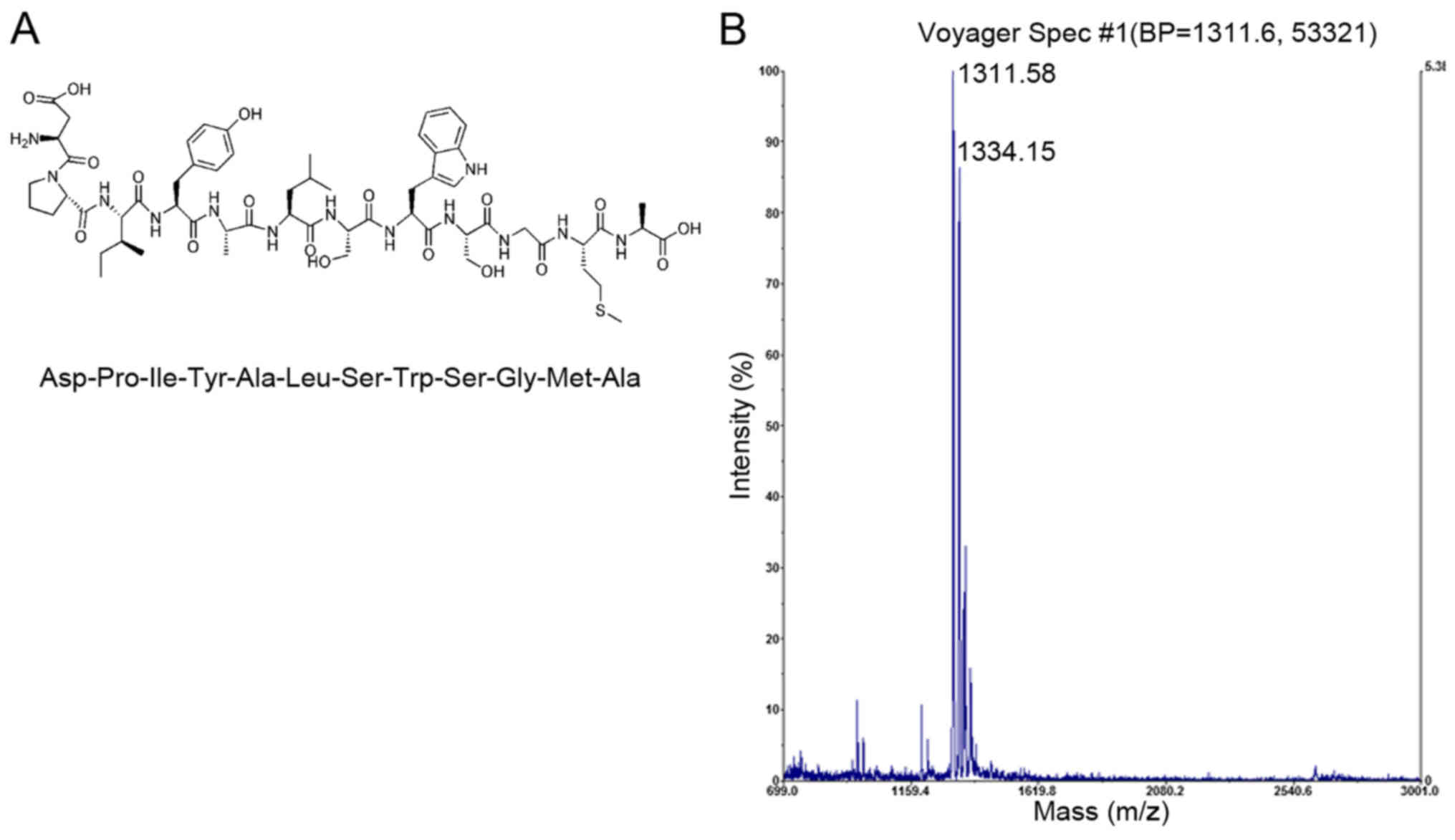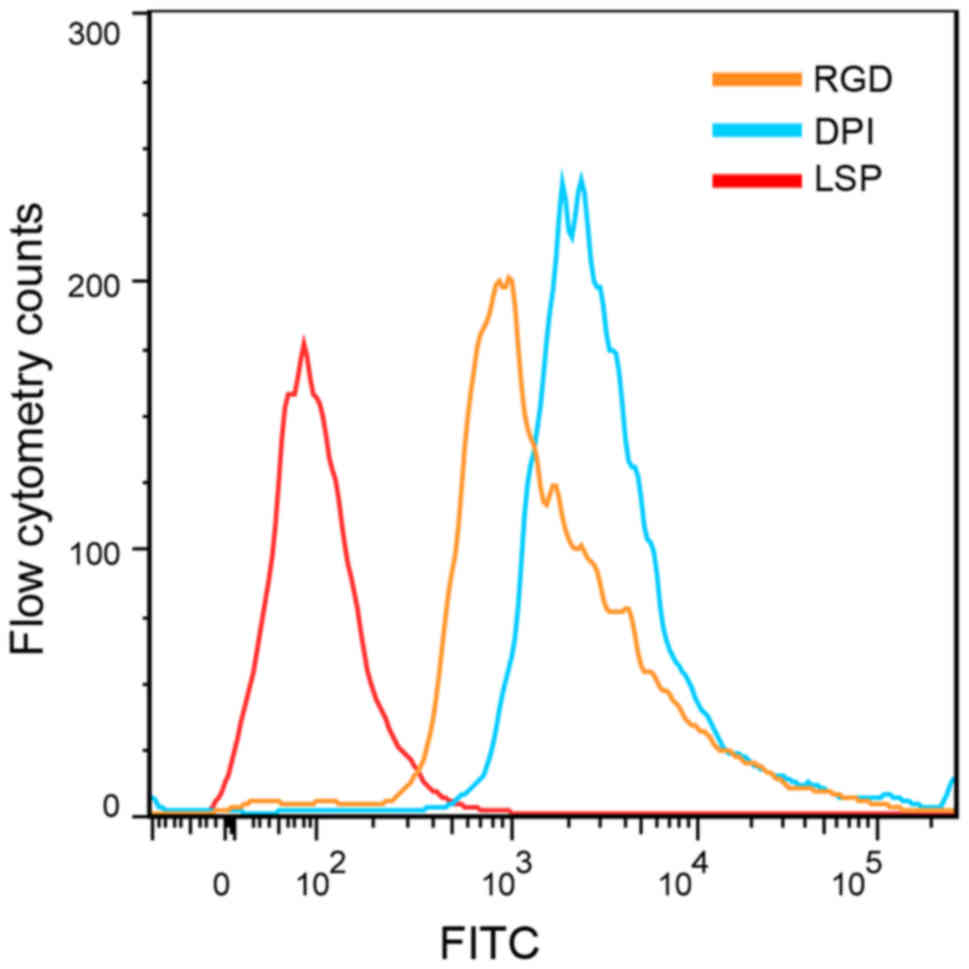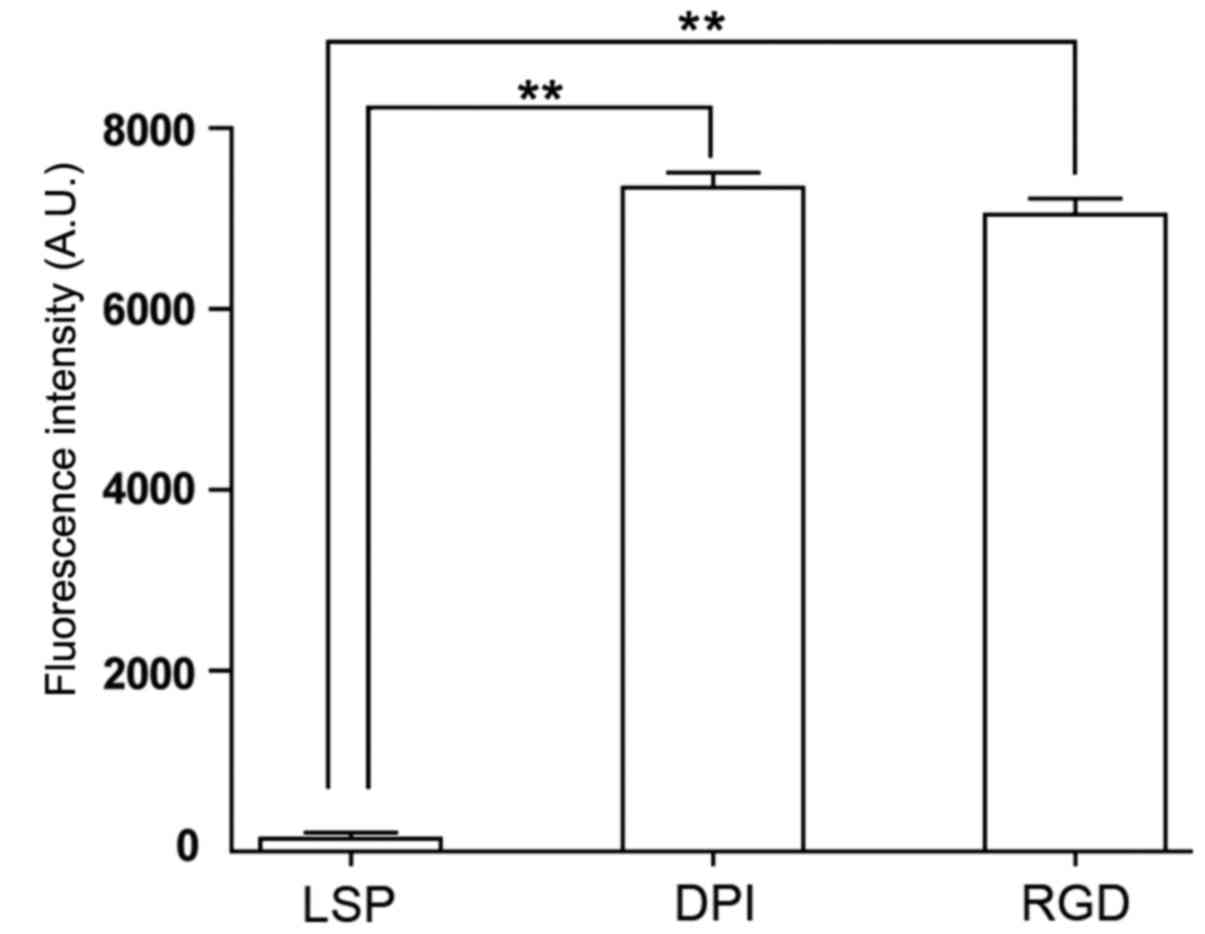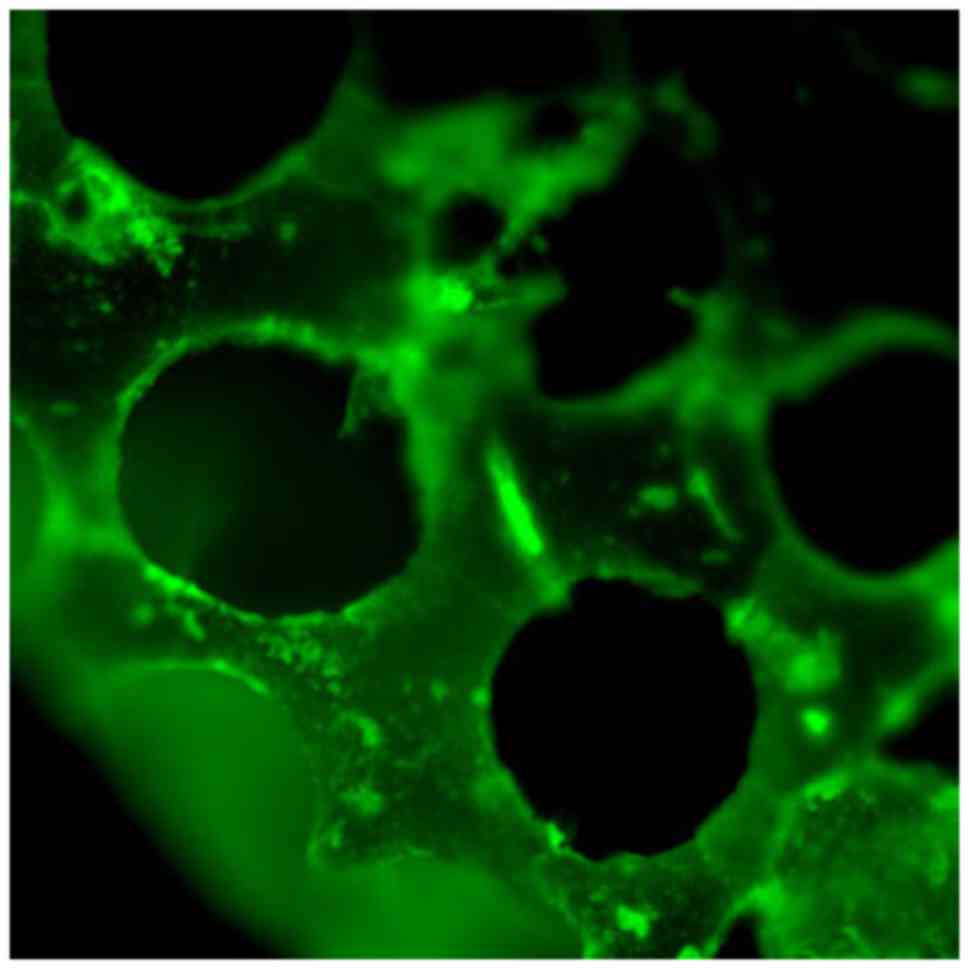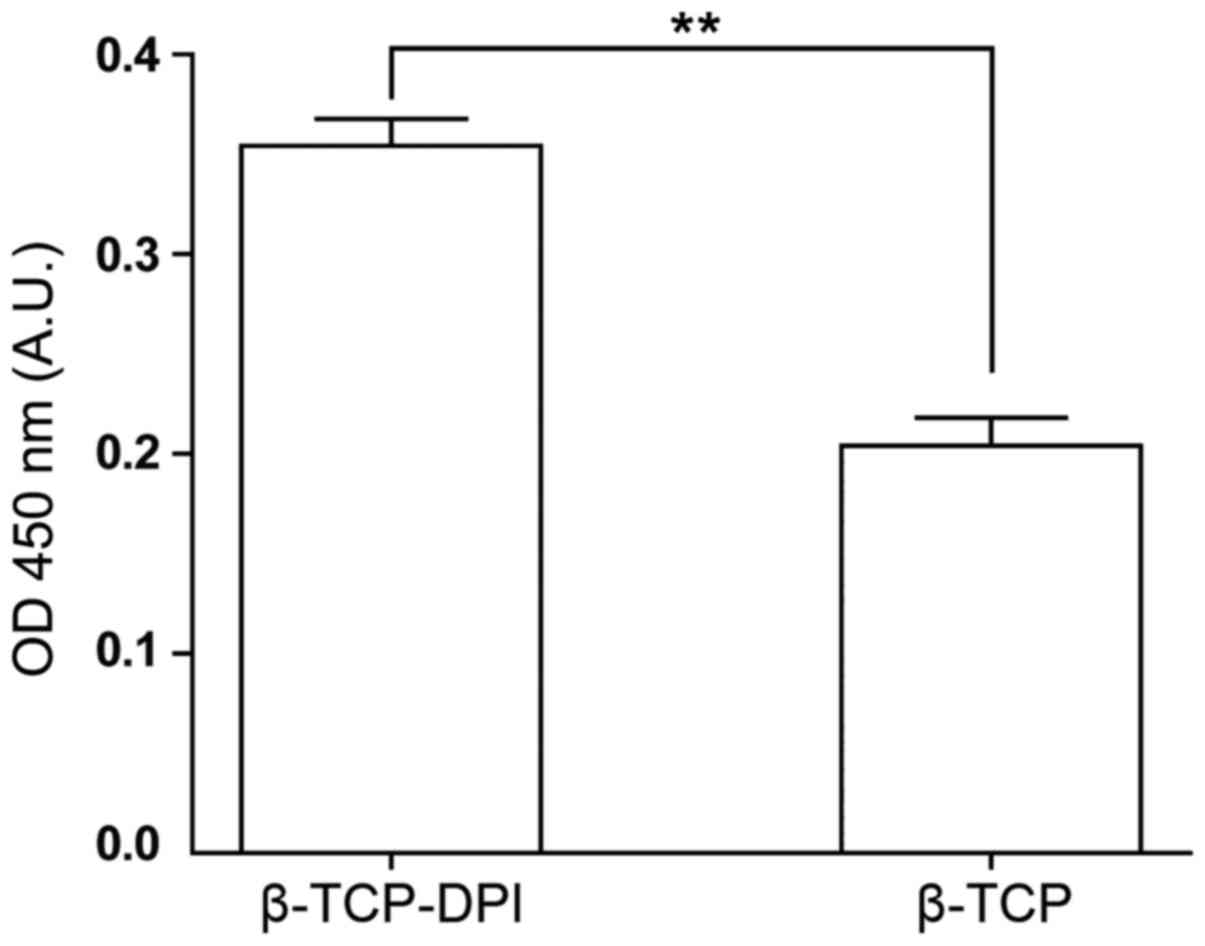Enhanced adhesion and proliferation of bone marrow mesenchymal stem cells on β‑tricalcium phosphate modified by an affinity peptide
- Authors:
- Published online on: November 13, 2018 https://doi.org/10.3892/mmr.2018.9655
- Pages: 375-381
-
Copyright: © Wang et al. This is an open access article distributed under the terms of Creative Commons Attribution License.
Abstract
Introduction
Refractory diseases, including osteonecrosis of the femoral head, are a growing worldwide health problem (1), and the potential of tissue engineering strategies for their treatment are currently being investigated. The fundamental elements of tissue engineering include scaffolds, signals and cells. Tissue engineering scaffolds are cytocompatible biomaterials that cells adhere to and/or replace with extracellular matrix (ECM) to produce native tissues (2). Scaffolds are usually classified on the basis of their source and ability to degrade. Tricalcium phosphate (TCP) is a synthetic, degradable inorganic material that has good biocompatibility, bioactivity and biodegradability; it is an ideal tissue repair material (3). TCP is commonly used at low temperature β phase, and β-TCP is mainly composed of calcium and phosphorus, similar to the inorganic composition of bone (4). However, it is a challenging material owing to its hydrophobicity and the absence of active groups to interact with cells of interest.
Mesenchymal stem cells (MSCs) are the most common type of cell used in orthopedic tissue engineering. MSCs have the potential to differentiate into osteoblasts, chondrocytes and adipocytes (5). At present, bone marrow-derived MSCs (BMSCs) are considered the gold standard for use in tissue engineering (2). However, pathological tissues often have poor innate regenerative capacity, with few or no viable MSCs (2). In tissue engineering and regenerative medicine, seed cells (for example, BMSCs) should be combined with scaffolds to repair tissues of interest (6). Strategies for taking full advantage of biomaterials and the efficient recruitment of MSCs are being increasingly investigated (7). The precise and efficient adhesion of MSCs to biomaterials requires investigation.
A number of attempts to enhance the affinity between cells and biomaterials have been conducted, and surface modification of biomaterials is widely used. For example, the heptapeptide sequence, LTHPRWP (L7), with affinity towards synovium-derived mesenchymal stem cells (SMSCs) has been covalently conjugated to polycaprolactone electrospun meshes and to human decalcified bone scaffolds; this elevates the adhesion and spreading of SMSCs on scaffolds (8). A chondrocyte-affinity peptide (CAP), DWRVIIPPRPSA, was identified by phage display technology (9). Polyethylenimine has been covalently modified with CAP to construct a non-viral vector for cartilage-targeted therapy (9). A previous study revealed the enhanced adhesion of human dermal fibroblasts on anorganic bovine bone mineral modified by the functional synthetic 15-residue peptide sequence GTPGPQGIAGQRQVV (P-15), which is a potent cell-binding domain in the α1 chain of type I collagen (10,11). The RGD peptide, derived from fibronectin in ECM, was demonstrated to promote cell adhesion in 1984 (12); since then, a number of materials modified with RGD have been used in academic study and clinical therapies (13,14).
Affinity peptides towards BMSCs are also commonly used. Recently, a novel peptide, DPIYALSWSGMA (DPI), with specific affinity towards BMSCs, was identified through phage display technology (15). In the present study, the affinity of the DPI peptide towards BMSCs was further verified. β-TCP was selected as the scaffold modified by DPI and cellular behavior on the modified scaffold was studied.
Materials and methods
Cell culture
C57BL/6 mouse BMSCs (cat. no. MUBMX-01001) were obtained from Cyagen Biosciences, Inc. (Santa Clara, CA, USA). The cells were cultured in cell culture flasks in a humidified atmosphere with 5% CO2 at 37°C (Fig. 1). Cells were cultured in low glucose Dulbecco's modified Eagle's medium (cat. no. 01-051-1A; Biological Industries, Kibbutz Beit-Haemek, Israel) with L-glutamine containing 10% fetal bovine serum (cat. no. 10099141; Gibco; Thermo Fisher Scientific, Inc., Waltham, MA, USA) and antibiotics (100 U/ml penicillin and 0.1 mg/ml streptomycin; cat. no. 15140122; Gibco; Thermo Fisher Scientific, Inc.). The medium was replaced every 2–3 days. Cells were detached and passaged at 80–90% confluency. BMSCs were used at passage 4–5 for further experiments.
Peptide synthesis
The DPI peptide sequence with high affinity towards BMSCs (Fig. 2A) was previously discovered using phage display (15). The linear dodecapeptide was derived from the Ph.D.-12 phage display library (cat. no. E8110S; New England Biolabs, Inc., Ipswich, MA, USA). The molecular weight of the synthesized DPI peptide was confirmed to be 1,311.58 Da by mass spectrometry (JBI Scientific, LLC, Huntsville, TX, USA) using matrix-assisted laser desorption/ionization-time of flight method with positive mode (Fig. 2B). The synthesized DPI peptide was dissolved in 50% acetonitrile (ACN) with 0.05% trifluoroacetic acid (TFA) to obtain a concentration of 100 µg/ml, and subsequently mixed with α-cyano-4-hydroxycinnamic acid solution (10 mg/ml in 50% ACN, 0.05% TFA) at a 1:1 ratio. A total of 1 µl of the mixture was loaded on target plate and air dried. The instrument settings were: 20,000 V accelerating voltage, 95% grid voltage, acquisition mass range between 600 and 2,000 Da, and extraction delay time was 200 nsec. A peptide sequence of the same chain length as DPI, but scrambled (LSPSAGAYIDWM; LSP), was used as the negative control. A peptide comprising three amino acids (RGD) was used as the positive control. All peptides were synthesized by solid-phase peptide synthesis using 9-fluorenylmethoxycarbonyl chemistry (Scilight-Peptide, Inc.; Scilight Biotechnology, LLC Beijing, China). An extra aminohexanoic acid was linked at the amino-terminus of all peptides to facilitate fluorescein-5-isothiocyanate (FITC) labeling. The FITC-labeled peptides, FITC-DPI, FITC-LSP and FITC-RGD, were stored at −20°C. A concentration of 1 mg/ml was obtained by dissolving the peptides in PBS (cat. no. 02-024-1A; Biological Industries) before use.
Peptide-affinity assay by flow cytometry
The C57BL/6 mouse BMSCs were washed twice with PBS and dissociated with 0.25% trypsin-EDTA (cat. no. 25200-056; Gibco; Thermo Fisher Scientific, Inc.). The cell suspension was centrifuged at 250 × g for 5 min at room temperature to collect cell sedimentation. The cells were incubated with 100 µM FITC-labeled peptides for 1 h at 37°C to allow cell binding and internalization. The mouse BMSC affinity properties of the peptides were analyzed quantitatively using flow cytometry at a wavelength of 488 nm and FlowJo v7.6.1 (Tree Star, Inc., Ashland, OR, USA) software. All procedures were repeated at least three times.
Peptide-affinity assay by fluorescence cytochemistry
C57BL/6 mouse BMSCs were cultured in 24-well dishes until 70–90% confluence was achieved. The cells were subsequently incubated with 100 µM FITC-labeled peptides for 1 h at 37°C and with rhodamine-labeled phalloidin (cat. no. CA1610; Beijing Solarbio Science & Technology Co., Ltd., Beijing, China) for 30 min at room temperature for cytoskeletal staining. The nuclei were counterstained with DAPI (cat. no. C0065; Beijing Solarbio Science & Technology Co., Ltd.). The cells were examined in the 24-well dishes using a fluorescence microscope. All procedures were repeated at least three times.
Synthesis of DPI-modified β-TCP (β-TCP-DPI)
The synthesis of β-TCP-DPI was conducted following a previously described procedure (10,16). Functional β-TCP scaffolds were constructed using DPI peptides that were adsorbed onto β-TCP through an adsorption/freeze-drying strategy. Briefly, disk-shaped β-TCP (diameter, 6 mm; height, 2 mm; Shanghai Bio-lu Biomaterials Co., Ltd, Shanghai, China) was incubated for 24 h at room temperature in peptide solution containing 100 µg/ml DPI in PBS in a ratio of 1.0 g β-TCP to 2.0 ml solution with gentle agitation to ensure to equilibrate the peptide over all exposed surfaces of the microporous β-TCP. Unadsorbed peptide was removed from the scaffolds by washing five times in PBS with gentle shaking over a 24 h period. The β-TCP-DPI composites were dried in vacuo for 1 h and stored at −20°C in moisture-proof containers. FITC-DPI peptide-modified β-TCP was also synthesized and observed using ImageXpress Micro Confocal (Molecular Devices, LLC, Sunnyvale, CA, USA). The β-TCP and β-TCP-DPI composites were sterilized under ultraviolet (UV) light for cell culture experiments.
Behavior of cells on β-TCP-DPI in vitro
C57BL/6 mouse BMSCs were seeded at passage 4–5 onto pure β-TCP and β-TCP-DPI scaffolds to investigate cell adhesion and proliferation, as described below. All scaffolds were sterilized through UV light exposure on a clean bench before use.
Cell adhesion assay
Cell Counting Kit-8 (CCK-8; cat. no., 96992; Sigma-Aldrich; Merck KGaA, Darmstadt, Germany) was used to evaluate the number of cells adhered onto the scaffolds (17). The cells were dissociated with 0.25% trypsin-EDTA. The cell suspension was centrifuged at 250 × g for 5 min at room temperature and the sediment was collected. Cells were resuspended at a specified concentration (6×104 cells/ml) and an appropriate volume (200 µl) in serum-free DMEM. The cell suspension was added to 96-well plates containing β-TCP and β-TCP-DPI and incubated for 3 h in a humidified atmosphere with 5% CO2 at 37°C; the scaffolds were removed to new wells and washed thrice with PBS. Subsequently, 100 µl fresh medium and 10 µl CCK-8 reagent were added and the BMSCs that adhered to the scaffolds were incubated for another 4 h at 37°C. The absorbance was measured at 450 nm using an automated microplate reader. All procedures were repeated at least three times.
Cell proliferation assay
CCK-8 assay was used to measure proliferation of cells on β-TCP-DPI and unmodified β-TCP scaffolds. C57BL/6 mouse BMSCs were seeded onto the unmodified β-TCP and β-TCP-DPI scaffolds. Briefly, a total of 30 µl cell suspension containing 2×103 cells was slowly and carefully pipetted onto the center-top surface of each β-TCP and β-TCP-DPI disk. The cell suspension was not allowed to contact the sides of the wells to ensure that all cells adhered to the scaffolds. Plates were gently placed into an incubator. After 3-h incubation, an extra volume (170 µl) fresh medium was added to each well gently and slowly along the edge of the well; wells were not rinsed to avoid washing out cells that did not firmly adhere to the scaffolds. After 3 days of incubation, the scaffolds were washed thrice with PBS and incubated with CCK-8 solution at 37°C for 3 h. Absorbance was measured at 450 nm with an automated microplate reader. All procedures were repeated at least three times.
Statistical analysis
Data are expressed as the mean ± standard deviation. Student's t-test was performed to compare two groups and one-way analysis of variance followed by Dunnett's test was performed for comparison of multiple groups. SPSS v24.0 (IBM Corp., Armonk, NY, USA) software was used for data analysis. P<0.05 was considered to indicate a statistically significant difference.
Results
DPI has a highly specific affinity towards mouse BMSCs
The mouse BMSC affinity peptide DPI, the negative control peptide LSP and the positive control peptide RGD were used in this study. Mouse BMSCs were incubated for 1 h with FITC-labeled DPI, LSP or RGD, and analyzed by flow cytometry. The average fluorescence intensity was 7,343.5±167.6 for BMSCs incubated with FITC-DPI, 7,042.0±179.6 for BMSCs incubated with FITC-RGD and 132.0±80.6 for BMSCs incubated with FITC-LSP. The average fluorescence intensities for BMSCs incubated with FITC-DPI and FITC-RGD were significantly higher compared with BMSCs incubated with FITC-LSP (n=3; P<0.01; Figs. 3 and 4). The average fluorescence intensity of cells incubated with FITC-DPI was 55.6-fold higher than that of FITC-LSP. The cells were also observed under a fluorescence microscope. Strong fluorescent signals were observed in the cells incubated with FITC-DPI and FITC-RGD, whereas weak fluorescent signals were observed of the cells incubated with FITC-LSP (Fig. 5). These results suggested that the DPI peptide may have a high affinity for mouse BMSCs.
Successful synthesis of functional β-TCP scaffolds
FITC-DPI was adsorbed onto the β-TCP scaffolds for surface modification through an adsorption/freeze-drying strategy. Following adsorption, the β-TCP-DPI scaffolds exhibited homogeneous green fluorescence (Fig. 6). This result indicated successful adsorption of DPI onto the surface of β-TCP scaffolds and the successful construction of β-TCP-DPI composite materials.
Adhesion and proliferation of BMSCs onto the functional β-TCP-DPI scaffolds is enhanced compared with pure β-TCP scaffolds
In the cell adhesion assay, the number of adherent cells on the β-TCP-DPI composites was significantly higher compared with those on the pure β-TCP scaffolds, according to optical density (OD) measurements (n=3; P<0.01; Fig. 7). This result indicated that the β-TCP-DPI composites are effective for mouse BMSC adhesion.
A CCK-8 assay was used to evaluate cell proliferation on pure β-TCP and β-TCP-DPI scaffolds. Following 3 days of incubation, the OD value of β-TCP-DPI scaffolds was significantly higher compared with pure β-TCP scaffolds, which indicated that β-TCP-DPI may enhance BMSC proliferation compared with unmodified β-TCP (n=3; P<0.01; Fig. 8).
Discussion
Tissue engineering uses concepts of biology and engineering to develop functional substitutes for damaged tissue (18), and MSCs are a common type of seed cell used for tissue engineering. MSCs in human bone marrow have been estimated to comprise 0.001–0.01% of the total nucleated cells, and this number declines with age (19). Furthermore, MSCs are rare or absent in pathological tissues such as the necrotic femoral head (2). A number of studies have proposed that host progenitor cells build new bone following recruitment to the site of repair (20,21). A method of efficient recruitment and utilization of the limited number of MSCs remains to be established. The strategy of recruiting BMSCs using affinity peptides is commonly adopted (14,22). Phage display provides a novel method for searching of highly specific affinity peptides towards BMSCs. In this way, a number of peptide sequences with highly specific affinity towards BMSCs have been identified and used to modify biomaterials to improve their surface properties and functions. For example, the peptide sequence EPLQLKM (E7) is widely used to enhance the interaction between BMSCs and various scaffolds (6,23–26). In the present study, the DPI peptide, with affinity towards BMSCs, was also reported to be discovered through phage display (15). Flow cytometry and fluorescence cytochemistry were used to confirm the high affinity of DPI towards BMSCs. It was also demonstrated that the β-TCP-DPI scaffolds enhanced the adhesion and proliferation of BMSCs compared with pure β-TCP scaffolds.
β-TCP is commonly used in absorbable bioceramics (27). In tissue engineering, β-TCP is an ideal biomaterial for the repair of osteonecrosis or bone defects (2,28). β-TCP has been extensively studied and applied as a bone repair and bone tissue engineering scaffold material (27). It is non-cytotoxic and has excellent biocompatibility and osteo-conductivity (3,4). Stable associations between peptides and materials are essential for the construction of functional scaffolds (13). Methods of connecting peptide molecules to materials include covalent attachment, blending, co-polymerization, chemical and physical treatment (13). As an inorganic material, β-TCP has no innate biological stimulatory activity and lacks functional groups. Biomolecules are, therefore, difficult to conjugate to β-TCP (29). Amino acids, peptides and proteins can be adsorbed to inorganic materials (30–32). The mechanism of adsorption involves the formation of complexes between the carboxyl group and surface Ca2+, between free amino or guanidine groups and the phosphate group (10). Thus, an adsorption/freeze-drying strategy was used in the present study to modify β-TCP scaffolds with DPI (10,16,33). In the process of synthesizing functional β-TCP, unadsorbed peptide should be rinsed sufficiently; otherwise non-adsorbed peptide molecules may dissolve in the cell culture medium and inhibit cell adhesion (12).
The present study aimed to investigate the ability of C57BL/6 mouse BMSCs to adhere and proliferate on β-TCP-DPI scaffolds. In the cell adhesion assay, the CCK-8 assay was used to detect the number of adherent cells on the scaffolds. It was hypothesized that BMSCs would be recruited onto the β-TCP-DPI scaffolds more strongly and rapidly compared with the pure β-TCP scaffolds. Cell adhesion to substrates is time-dependent, and experimental adhesion time should be carefully considered (13). It usually assessed 1–4 h after cell seeding, and in the present study, 3 h was selected as the time point of verification. The results indicated that the adhesion of BMSCs to the functional β-TCP scaffolds was enhanced compared with the pure β-TCP scaffolds.
Numerous biomolecules have been reported to promote the proliferation of BMSCs (6,34). Therefore, it was considered necessary to study the effect of the functional β-TCP scaffolds on proliferation. In cell adhesion assay, cell suspension was added into the wells and cells adhered to the scaffolds freely. In cell proliferation assay, cells were seeded onto the scaffolds restrictedly; cell suspension was carefully placed onto the center-top surface of the scaffolds to ensure that all cells adhered to the scaffolds. Therefore, the initial number of cells growing on scaffolds was fixed to accurately investigate the changes of cell proliferation. The result indicated that DPI-modified β-TCP scaffolds promoted the proliferation of BMSCs.
Additional studies are required to investigate the underlying mechanism of the affinity peptide towards BMSCs. The repair effect of the functional β-TCP-DPI scaffolds should also be further studied and evaluated in vivo.
In the present study, functional β-TCP scaffolds were successfully synthesized by adsorption of the BMSC affinity peptide, DPI, onto the surface of β-TCP using an adsorption/freeze-drying strategy. In vitro experiments demonstrated that the adhesion and proliferation of BMSCs on the functional β-TCP scaffolds was enhanced. The functional scaffold may be used as a potent biomaterial for MSC-based tissue engineering therapy.
Acknowledgements
The authors would like to thank Dr Nianping Zhang, Dr Tiantong Sun and Dr Li Qiao for revising the manuscript.
Funding
The present study was supported by The National Natural Science Foundation of China (grant no. 81271966).
Availability of data and materials
The data sets generated and analyzed during the current study are available from the corresponding author on reasonable request.
Authors' contributions
GW, ZM and SS designed the experiments. GW performed the experiments. GW, HX, YL and CW analyzed the data. GW wrote the manuscript. GW revised the manuscript. All authors reviewed the manuscript.
Ethics approval and consent to participate
Not applicable.
Patient consent for publication
Not applicable.
Competing interests
The authors declare they have no competing interests.
References
|
Mont MA, Cherian JJ, Sierra RJ, Jones LC and Lieberman JR: Nontraumatic osteonecrosis of the femoral head: Where do we stand today? A ten-year update. J Bone Joint Surg Am. 97:1604–1627. 2015. View Article : Google Scholar : PubMed/NCBI | |
|
Tatara AM and Mikos AG: Tissue engineering in orthopaedics. J Bone Joint Surg Am. 98:1132–1139. 2016. View Article : Google Scholar : PubMed/NCBI | |
|
Ke D, Dernell W, Bandyopadhyay A and Bose S: Doped tricalcium phosphate scaffolds by thermal decomposition of naphthalene: Mechanical properties and in vivo osteogenesis in a rabbit femur model. J Biomed Mater Res B Appl Biomater. 103:1549–1559. 2015. View Article : Google Scholar : PubMed/NCBI | |
|
LeGeros RZ: Properties of osteoconductive biomaterials: Calcium phosphates. Clin Orthop Relat Res. 81–98. 2002. View Article : Google Scholar : PubMed/NCBI | |
|
Pittenger MF, Mackay AM, Beck SC, Jaiswal RK, Douglas R, Mosca JD, Moorman MA, Simonetti DW, Craig S and Marshak DR: Multilineage potential of adult human mesenchymal stem cells. Science. 284:143–147. 1999. View Article : Google Scholar : PubMed/NCBI | |
|
Li Q, Xing D, Ma L and Gao C: Synthesis of E7 peptide-modified biodegradable polyester with the improving affinity to mesenchymal stem cells. Mater Sci Eng C Mater Biol Appl. 73:562–568. 2017. View Article : Google Scholar : PubMed/NCBI | |
|
Herrmann M, Verrier S and Alini M: Strategies to stimulate mobilization and homing of endogenous stem and progenitor cells for bone tissue repair. Front Bioeng Biotechnol. 3:792015. View Article : Google Scholar : PubMed/NCBI | |
|
Shao ZX, Zhang X, Pi YB, Yin L, Li L, Chen H, Zhou C and Ao Y: Surface modification on polycaprolactone electrospun mesh and human decalcified bone scaffold with synovium-derived mesenchymal stem cells-affinity peptide for tissue engineering. J Biomed Mater Res A. 103:318–329. 2015. View Article : Google Scholar : PubMed/NCBI | |
|
Pi Y, Zhang X, Shi J, Zhu J, Chen W, Zhang C, Gao W, Zhou C and Ao Y: Targeted delivery of non-viral vectors to cartilage in vivo using a chondrocyte-homing peptide identified by phage display. Biomaterials. 32:6324–6332. 2011. View Article : Google Scholar : PubMed/NCBI | |
|
Qian JJ and Bhatnagar RS: Enhanced cell attachment to anorganic bone mineral in the presence of a synthetic peptide related to collagen. J Biomed Mater Res. 31:545–554. 1996. View Article : Google Scholar : PubMed/NCBI | |
|
Bhatnagar RS, Qian JJ and Gough CA: The role in cell binding of a beta-bend within the triple helical region in collagen alpha 1 (I) chain: Structural and biological evidence for conformational tautomerism on fiber surface. J Biomol Struct Dyn. 14:547–560. 1997. View Article : Google Scholar : PubMed/NCBI | |
|
Pierschbacher MD and Ruoslahti E: Cell attachment activity of fibronectin can be duplicated by small synthetic fragments of the molecule. Nature. 309:30–33. 1984. View Article : Google Scholar : PubMed/NCBI | |
|
Hersel U, Dahmen C and Kessler H: RGD modified polymers: Biomaterials for stimulated cell adhesion and beyond. Biomaterials. 24:4385–4415. 2003. View Article : Google Scholar : PubMed/NCBI | |
|
Zhang H and Hollister S: Comparison of bone marrow stromal cell behaviors on poly (caprolactone) with or without surface modification: Studies on cell adhesion, survival and proliferation. J Biomater Sci Polym Ed. 20:1975–1993. 2009. View Article : Google Scholar : PubMed/NCBI | |
|
Ramaraju H, Miller SJ and Kohn DH: Dual-functioning peptides discovered by phage display increase the magnitude and specificity of BMSC attachment to mineralized biomaterials. Biomaterials. 134:1–12. 2017. View Article : Google Scholar : PubMed/NCBI | |
|
Bhatnagar RS, Qian JJ, Wedrychowska A, Sadeghi M, Wu YM and Smith N: Design of biomimetic habitats for tissue engineering with P-15, a synthetic peptide analogue of collagen. Tissue Eng. 5:53–65. 1999. View Article : Google Scholar : PubMed/NCBI | |
|
Zhang HX, Zhang XP, Xiao GY, Hou Y, Cheng L, Si M, Wang SS, Li YH and Nie L: In vitro and in vivo evaluation of calcium phosphate composite scaffolds containing BMP-VEGF loaded PLGA microspheres for the treatment of avascular necrosis of the femoral head. Mater Sci Eng C Mater Biol Appl. 60:298–307. 2016. View Article : Google Scholar : PubMed/NCBI | |
|
Langer R and Vacanti JP: Tissue engineering. Science. 260:920–926. 1993. View Article : Google Scholar : PubMed/NCBI | |
|
Maijenburg MW, van der Schoot CE and Voemans C: Mesenchymal stromal cell migration: Possibilities to improve cellular therapy. Stem Cells Dev. 21:19–29. 2012. View Article : Google Scholar : PubMed/NCBI | |
|
Caplan AI: New era of cell-based orthopedic therapies. Tissue Eng Part B Rev. 15:195–200. 2009. View Article : Google Scholar : PubMed/NCBI | |
|
Caplan AI: Why are MSCs therapeutic? New data: New insight. J Pathol. 217:318–324. 2009. View Article : Google Scholar : PubMed/NCBI | |
|
Zhang H, Lin CY and Hollister SJ: The interaction between bone marrow stromal cells and RGD-modified three-dimensional porous polycaprolactone scaffolds. Biomaterials. 30:4063–4069. 2009. View Article : Google Scholar : PubMed/NCBI | |
|
Shao Z, Zhang X, Pi Y, Wang X, Jia Z, Zhu J, Dai L, Chen W, Yin L, Chen H, et al: Polycaprolactone electrospun mesh conjugated with an MSC affinity peptide for MSC homing in vivo. Biomaterials. 33:3375–3387. 2012. View Article : Google Scholar : PubMed/NCBI | |
|
Meng Q, Man Z, Dai L, Huang H, Zhang X, Hu X, Shao Z, Zhu J, Zhang J, Fu X, et al: A composite scaffold of MSC affinity peptide-modified demineralized bone matrix particles and chitosan hydrogel for cartilage regeneration. Sci Rep. 5:178022015. View Article : Google Scholar : PubMed/NCBI | |
|
Huang H, Zhang X, Hu X, Shao Z, Zhu J, Dai L, Man Z, Yuan L, Chen H, Zhou C and Ao Y: A functional biphasic biomaterial homing mesenchymal stem cells for in vivo cartilage regeneration. Biomaterials. 35:9608–9619. 2014. View Article : Google Scholar : PubMed/NCBI | |
|
Man Z, Yin L, Shao Z, Zhang X, Hu X, Zhu J, Dai L, Huang H, Yuan L, Zhou C, et al: The effects of co-delivery of BMSC-affinity peptide and rhTGF-β1 from coaxial electrospun scaffolds on chondrogenic differentiation. Biomaterials. 35:5250–5260. 2014. View Article : Google Scholar : PubMed/NCBI | |
|
Liu B and Lun DX: Current application of β-tricalcium phosphate composites in orthopaedics. Orthop Surg. 4:139–144. 2012. View Article : Google Scholar : PubMed/NCBI | |
|
Rh Owen G, Dard M and Larjava H: Hydoxyapatite/beta-tricalcium phosphate biphasic ceramics as regenerative material for the repair of complex bone defects. J Biomed Mater Res B Appl Biomater. 106:2493–2512. 2018. View Article : Google Scholar : PubMed/NCBI | |
|
Alvarez LM, Rivera JJ, Stockdale L, Saini S, Lee RT and Griffith LG: Tethering of epidermal growth factor (EGF) to beta tricalcium phosphate (βTCP) via fusion to a high affinity, multimeric βTCP-binding peptide: Effects on human multipotent stromal cells/connective tissue progenitors. PLoS One. 10:e01296002015. View Article : Google Scholar : PubMed/NCBI | |
|
Moreno EC, Kresak M and Hay DI: Adsorption of molecules of biological interest onto hydroxyapatite. Calcif Tissue Int. 36:48–59. 1984. View Article : Google Scholar : PubMed/NCBI | |
|
Hay DI and Moreno EC: Differential adsorption and chemical affinities of proteins for apatitic surfaces. J Dent Res. 58:930–942. 1979. View Article : Google Scholar : PubMed/NCBI | |
|
Gorbunoff MJ and Timasheff SN: The interaction of proteins with hydroxyapatite. III. Mechanism. Anal Biochem. 136:440–445. 1984. View Article : Google Scholar : PubMed/NCBI | |
|
Yang XB, Bhatnagar RS, Li S and Oreffo RO: Biomimetic collagen scaffolds for human bone cell growth and differentiation. Tissue Eng. 10:1148–1159. 2004. View Article : Google Scholar : PubMed/NCBI | |
|
Parrish B, Breitenkamp RB and Emrick T: PEG- and peptide-grafted aliphatic polyesters by click chemistry. J Am Chem Soc. 127:7404–7410. 2005. View Article : Google Scholar : PubMed/NCBI |




